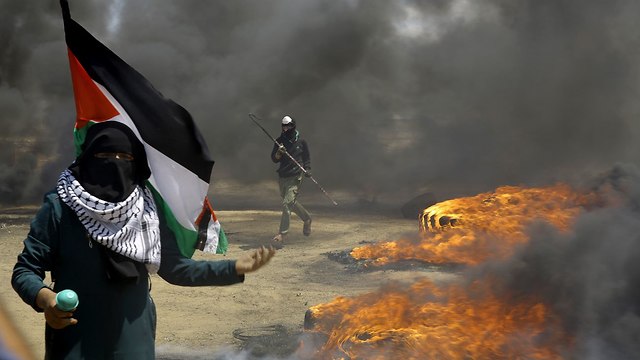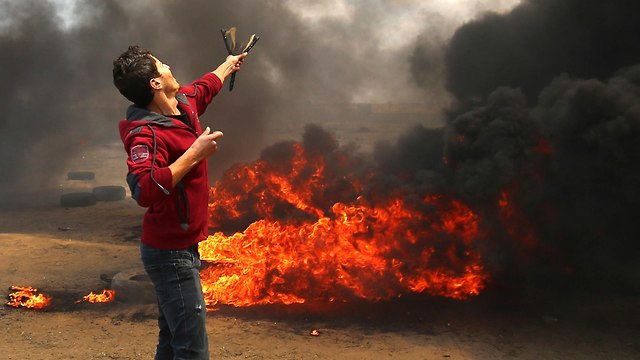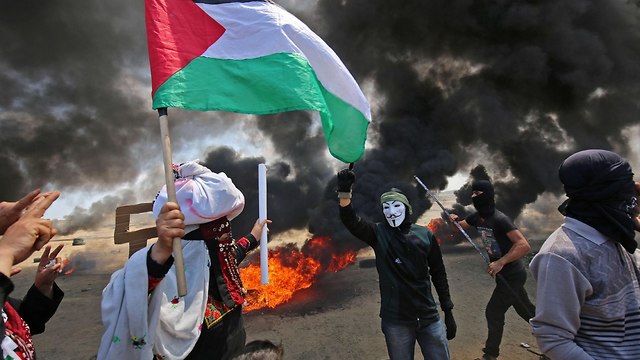

Hamas incites violence to hide its own shortcomings
Op-ed: As self-interest appears to be Hamas' only guiding principle, it seems appropriate to warn the group that if they continue to escalate tensions with Israel as a way to deflect from their own failures, they run the risk of losing control of the situation and being dragged into a war they do not want and cannot win.
As the May 15 culmination of the Gaza protests approaches, Israel continues to strive to minimize casualties on both sides while Hamas aims for the opposite.
Since it took control of Gaza, Hamas has failed politically, economically, and militarily, and found itself in search of a new strategy. Its recent decision to lead violent protests along Gaza’s border with Israel indicates the adoption of an approach that seeks to confront Israel below the threshold of war and in an arena in which it has comparative advantages—in this case, it is the fight for global public opinion.
By doing so, Hamas aims to place Israel in a dilemma: to protect its sovereignty and border security Israel must neutralize individuals (some armed and others unarmed) attempting to storm the border at the expense of its international image, while failing to defend its boundaries could result in mass border infiltration and many dead on both sides. However, the IDF has operated with exceptional professionalism, and despite the fog of war it has achieved three important aims: protected the integrity of its border and avoided Israeli civilian and military casualties, minimized the number of Palestinian civilians killed to the extent possible, and prevented escalation to a broader conflict.
Unfortunately for both sides, the new Hamas tactic appears to be another cynical ploy by the group to divert attention away from its failures. By heating things up in the struggle against Israel, Hamas aspires to position itself on the forefront of the Palestinian national movement and gain an advantage over its Palestinian Authority (PA) rivals. Therefore, the PA’s negative response to the protests—including a senior PA official calling the protest organizers frauds who send women, children and youths to their deaths—should come as no surprise. The PA official is certainly right about that: Hamas seeking to make political gains by convincing hundreds to attack a border fence protected by armed guards—practically a suicide mission in any part of the world—is despicable.
And it is quite clear that the protests are not about ending the Israeli occupation in Gaza (it ended in 2005), nor were they about improving dire living conditions (recent protests included disrupting the delivery of humanitarian aid by setting fire to the Kerem Shalom border crossing), rather they were about contesting the existence of the State of Israel. Palestinians themselves titled the events “marches of return” to Israel and sought to break down Israeli borders, in essence attempting to alter both the demographic character of the state and destroy something as fundamental as its boundaries. If there was any doubt regarding the ultimate aims of the protests, the plethora of Nazi symbols that protesters displayed allayed them.
It is also rather ironic that some of those in the international community who insist on the importance of the 1967 boundaries are now supporting those attempting to demolish those very lines. Any building of settlements beyond the Green Line in the West Bank provokes a furious response and apocalyptic predictions regarding Israel’s future, so it is quite odds that efforts to destroy that same 1967 line around Gaza do not receive similar criticism. In fact, it is the Israelis who are criticized for defending it. What is slowly becoming apparent is that for some groups, the dispute is not about geographic delineation but about a fundamental opposition to Israel.
While Israel did have the option to refrain from firing on those rushing its border, doing so would likely have led to many more deaths. If those charging the fence were not deterred, many more might have joined and they might have gotten through to the other side where there are several vulnerable Israeli communities nearby. It is no stretch to think that there were terrorists among the protesters, as members of the crowd attacked Israeli troops with Molotov cocktails and explosive devices on numerous occasions—of course they did so within the cover of civilians. In a scenario in which a massive number of hostile individuals infiltrated the border, one could easily imagine that Israeli efforts to neutralize them would result in hundreds of dead, if not more.
All things considered, Israel has successfully managed to strike a delicate balance between instilling deterrence and avoiding provocations through heavy-handed tactics. Unfortunately but not surprisingly, in leading the protests and launching violent attacks from within them, Hamas has adopted yet another tactic that puts civilian lives at risk in order to achieve its own political aims; for years, the group has been committing war crimes such as launching rockets at Israeli civilians from densely populated Palestinian neighborhoods. As self-interest appears to be the group’s only guiding principle, it seems appropriate to warn Hamas that if they continue to escalate tensions with Israel as a way to deflect from their own failures, they run the risk of losing control of the situation and being dragged into a war they do not want and cannot win.
Maj. Gen. (ret.) Amos Yadlin was chief of Israeli military intelligence from 2006 to 2010 and is now the director of the Institute for National Security Studies. Ari Heistein is the special assistant to the director of the Institute for National Security Studies.


















